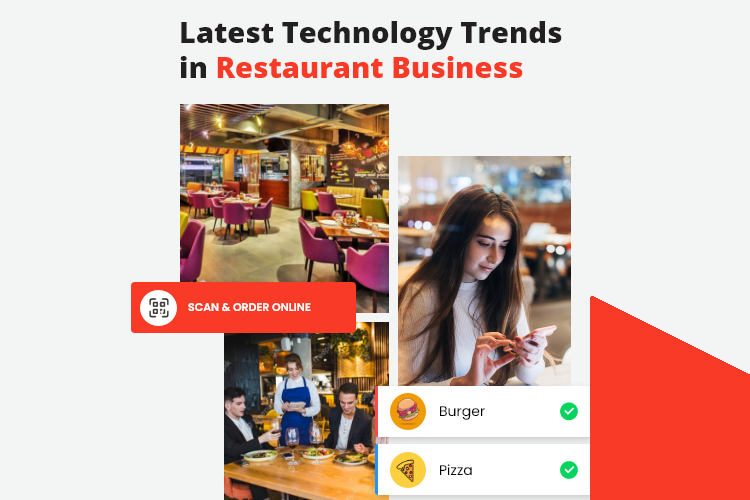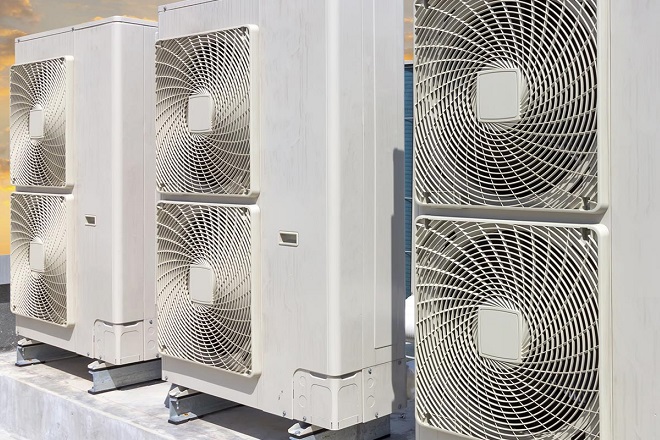Restaurants have been part and parcel of life as long as civilization has existed. There have been restaurants serving comfort and nourishment to the hungry, but with today’s technology, restaurants are beginning to undergo some transformative changes. The pandemic especially pushed traditional restaurants to adopt digital orders and online food deliveries.
So, to stay relevant with the current demands and ahead of the fierce competition, the industry is adopting restaurant technology trends in 2022. Restaurant owners are finding innovative ways to improve their services and experiences for guests.
Top 13 Latest Restaurant Technology Trends
If you are a restaurant owner finding ways to upgrade your restaurant and food delivery business, read the blog to discover the latest restaurant technology trends that will shape the industry in 2022.
Online Food Delivery
Online Food Ordering System and Delivery is more important than ever. With the emergence of new food delivery apps and more people staying in than ever, it’s no surprise that food delivery is crucial for any restaurant.
In the last decade, searches for food delivery apps have grown by 5600%. Each year, the global food delivery market makes up a larger part of the restaurant industry. Consequently, the food delivery industry is expected to grow to over 164 billion by 2022.
Virtual Kitchens
Virtual kitchens or ghost kitchens are popping up everywhere, also known as cloud or dark kitchens. These are separate cooking facilities that restaurant owners set to prepare food for delivery. There is nowhere for customers to dine in, and they can only order online. So customers never physically visit the business and interact with the staff.
Ghost kitchens provide more opportunities than traditional restaurant models, and many ghost kitchens contract with multiple restaurants simultaneously. As the boom in online ordering takes off, ghost kitchens are becoming more and more common, with an estimated 1500 of these kitchens in the US as of 2020.
The trend is expected to explode with 7500 in China and 3500 in India. The ghost kitchen market is expected to reach worth 1 trillion dollars by 2030.
Chuck-e-cheese, a major US restaurant franchise, currently runs a virtual restaurant called Pasquale’s pizza. Some restaurants have up to three to four virtual restaurants running out of the same kitchen. Virtual restaurants experienced their first year of real success in 2020, and by the end of 2020, there were an estimated 100 000 virtual restaurants in the US.
AI-Based Personalization
Restaurants are increasingly trying to discover new ways to personalize their customer experience. As per research, 79 consumers want personalized menu items based on personal data.
Chains like McDonald’s are looking to capture data on mass, and in 2019, the fast-food giant spent 300 million dollars to acquire Dynamic Yields, an AI and data collection company. The new tech personalizes the customer’s orders based on data from previous orders.
Many restaurant owners think customers feel uncomfortable sharing personal data with massive fast-food corporations. But the research is detailed; people aren’t that bothered. 84% of consumers are fine with giving their order history data to restaurants for a more personalized experience.
Contactless Payment (QR Code)
As per statistics, contactless payments will reach from $2 trillion to $6 trillion worldwide by 2024.
OR Code payment facility allows customers to pay through smartphones, cards, and smart watches. The pandemic pushed contactless payments as it is a more hygienic and safer means of payment with no cash handling and human contact.
Contactless payments are a quick and convenient way to receive payment from customers. Restaurants wishing to stay competitive are readily adopting contactless digital payment methods.
Voice Technology
Voice technology has become an indispensable feature in mobile apps, and the restaurant industry is no exception. Popular food brands like KFC and Pizza Hut enable customers to place food orders through voice technology.
Voice-enabled food orders offer a convenient ordering experience to customers. With integration with virtual assistants like Alexa, or Google Assistant, the food delivery apps can deliver better experiences to customers. Voice technology is gaining significant popularity and is here to stay.
Self-ordering Kiosks
A self-service kiosk allows customers to place orders and pay on their own. The self-ordering kiosk technology enables contactless service with no friction of waiting or delay. Since customers can order and pay at their convenience, they have enough time to explore the menu and order what they want. They get additional food item suggestions for better services. The kiosk is connected to the kitchen POS to send direct orders to the kitchen.
Self-ordering Kiosks help restaurant owners manage traffic during peak hours with no long waiting times. Thus, it helps them sell more, serve better, and earn higher. Moreover, the kiosk systems provide real-time insights into customer shopping preferences.
Handheld Order Taking Devices
A modern handheld restaurant ordering system can make your service more accurate and productive. Restaurant owners can serve more diners with instant orders and give them a pleasing ordering and dining experience.
With a handheld order-taking device, wait staff can instantly take each diner’s order on the smartphone or tablet. The order is directly sent to the appropriate members of the kitchen. So, the chefs receive the order instantly and can begin preparing the dish asap.
The wait staff automatically gets the alert when the order is ready for delivery so that they can serve immediately. Thus, waitstaff can reduce walks and rounds between kitchen and dining tables.
When the waitstaff has more time, they can interact with customers better, inform them about the restaurant’s special dishes and cuisines, and answer their queries. Thus, your customers will feel more special and served well.
Restaurant owners can serve more diners with instant food orders and even during a restaurant’s rush hours. You will not like it if your customers leave your restaurant due to long waits for food to be served.
Kitchen Display Systems(KDS)
A Kitchen Display System is a kiosk where the kitchen staff can view the menu digitally. The KDS displays all the dine-in and online orders and integrates well with the restaurant POS terminal. Thus, it helps in maintaining the consistency levels in food preparation. Further, the kitchen staff can keep track of inventory across the entire restaurant chain.
When the kitchen staff can view all the orders instantly and simultaneously, they can streamline meal preparations and organize items. It helps them make accurate and timely deliveries.
In addition, the Kitchen display system alerts kitchen staff if an order has been in the queue too long. Another benefit of the Kitchen Display System is that the front-of-house staff can check the real-time status of dishes being prepared on their mobile POS. Once they are ready, they can pick up the orders and serve them hot.
Chatbots
Another latest technology trend in the restaurant industry is chatbots. When customers place orders, the interactive chatbots offer a more personalized experience. They simplify customer tasks by answering their questions, processing orders, sending targeted promotional messages, etc.
Automated Inventory Management Software
The availability of the right food ingredients and groceries is essential for every restaurant. Restaurant owners can manage inventory and stock automatically with inventory management software.
The software tracks food and beverage stocks, and schedules reorder for stocks running short. Thus, it relieves staff and restaurant owners of the tedious and time-consuming task of managing inventory.
Online Table Reservation System
An online table reservation system allows customers to book a table in their favorite restaurant on their own. They can view available tables, choose a time, and book them online. Thus, they need not call the restaurant staff and wait for them to answer to know the table availability.
The benefits of an online food ordering system are plenty, and they make the life of restaurant staff much easier. They can save a lot of time efficiently focusing on serving their dine-in guests. Moreover, online table reservations also help avoid manual errors in reservations due to miscommunication on phone call reservations.
Drone Food Delivery Systems
Another technology trend in the restaurant industry gaining huge popularity is using drones for food deliveries. Restaurants relying on third-party delivery agencies can save huge money wasted in commissions. Drones also help restaurants deliver fast and swiftly with no traffic.
Moreover, drone food deliveries can greatly help promote restaurants as a brand and their services. People like creative and innovative services and would love a drone delivering their food parcels. The drones for restaurant food deliveries can also save the environment with fewer vehicles on the road.
Air Purification
Restaurants focus on giving customers an overall happy and satisfying dining experience. Air purification is another technology trend helping restaurant owners create a refreshing ambiance for their guests.
The purified and fragrant smell refreshes and alleviates guest moods. Thus, restaurant owners are using air purification techniques to improve the air quality inside their restaurants.
The air purification systems trap pollutants and emit clean air. Thus, it is also a COVID safety measure taken by restaurant owners to avoid the threat of viruses.
In addition, restaurants also follow strict COVID protection guidelines, like regular sanitization, wearing masks and gloves by staff, etc.
Conclusion
The latest restaurant technology trends enable business owners to keep up with the pace and meet the skyrocketing customer demands. Advanced technology has helped restaurants raise their customer experience standards in less time and effort. A satisfied customer is always a key to a successful business; thus, restaurants are adopting the latest technology to create a win-win situation for their food ordering and delivery business.
Archana Inani is the Head of Product Marketing at Foodiv with over almost 8 years of experience. She often writes about how digitizing the food industry with food ordering systems is revolutionary and revenue-generating. Having collaborated on many such articles, Archana has a creative knack in marketing and content writing for the same.




